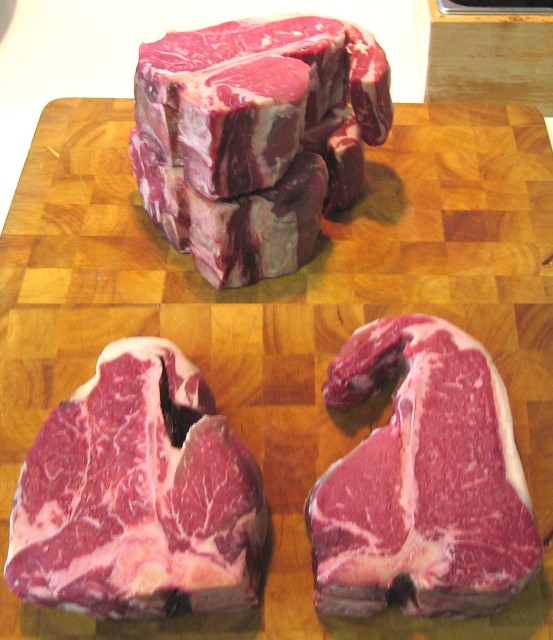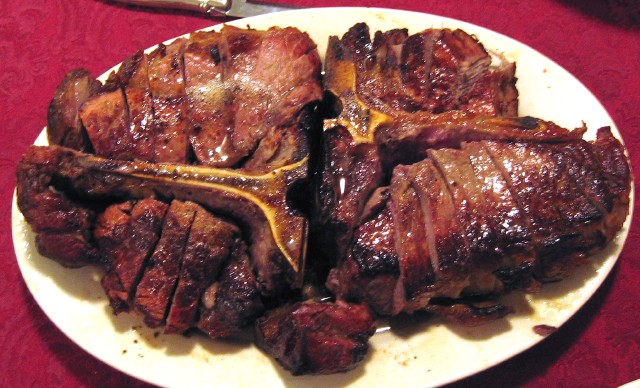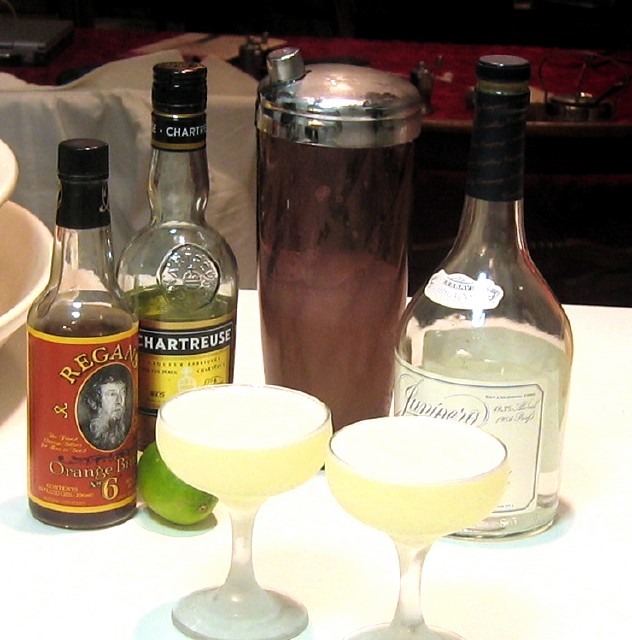-
Posts
11,151 -
Joined
Content Type
Profiles
Forums
Store
Help Articles
Posts posted by slkinsey
-
-
Per my cross-posted info above from the Consortio it seems likely to me that the special Aceto di Modena was always made with fermented concentrated grape must -- or certainly dating to much earlier than 1860 -- but that some makers also included wine in making a "second quality" product.
Wikipedia says that balsamic vinegar was popularized in the US and UK during the 1980s through the writing of Marcella Hazan. I'm not sure what the basis is for that assertion (especially since her seminal books were written in 1973 and 1978), but I do think there is something to that argument worth considering since I think it is reasonable to regard Hazan as the central figure who introduced and popularized real, traditional Italian cookery in the English-speaking world. It would also make sense, per your "aceto balsamico" versus "balsamic vinegar" idea, that manufacturers and/or importers would have started anglicizing the labling when they started viewing the product as one that would be marketed directly to Americans as opposed to importing the Italian products.
-
Some interesting facts from the Consortio Aceto Balsamico di Modena:
- It turns out that "balsamico" as part of the name is of relatively recent coinage, being found for the first time in the ducal inventories of 1747 at the Este Palace in Modena.
- In 1839, one Conte Giorgio Gallesio made a brief study of balsamico production in Modena, and his documents are among the first technical treatises on the subject. Therein, he notes the difference between two categories made, that exclusively made from fermented must (described as "exquisite") and that made from fermented must with the addition of wine (described as "also excellent"). I think it's somewhat likely that there were historically different grades and levels of balsamico produced, some with the addition of wine and some exclusively from must. It also seems likely that the balsamico produced exclusively from must would be considered to have the highest quality and would be the most expensive. Perhaps this later consolidated on the highest quality, and therefore came over time to mean "must only."
- Documents from the end of the 19th Century refer to products made from must and wine vinegar as well as shortcut methods involving the use of spices. Perhaps the first "industriale?"
- It turns out that "balsamico" as part of the name is of relatively recent coinage, being found for the first time in the ducal inventories of 1747 at the Este Palace in Modena.
-
One story, which we suspect is apocryphal, has the condiment’s popularity rise with Modena's other big export of the 1980s, Luciano Pavarotti. Any truth to this?
Luciano was already a huge star in the 1970s (he made his Italian debut in 1961 and made a huge splash in the US singing La fille du régiment with the (in)famous "nine high Cs" aria in 1971). So I think we can call that myth busted.
When did it get called "vinegar"? As it isn't made from wine I guess technically it isn't a 'vinegar' (and therefore neither is malt vinegar, which is an 'alegar'?), so if you can find out when 'balsamic vinegar' became common usage, this may help to pin-point 'ground zero'.I'm not sure I quite get this, although it's very possible that I'm just too dense to see what you're getting at. As far as I know, the traditional Italian product has always been called aceto balsamico (aceto meaning "vinegar" in Italian). Certainly it's been called that a lot longer than it has been popular outside of Italy.
There is also some question in my mind about your suggestion that aceto balsamico might not qualify as "vinegar" because it is not made from wine. If wine can be defined as fermented grape juice, wouldn't this apply to the raw material of aceto balsamico, which is fermented 50% reduced grape juice? I gather that your suggestion that only acetic-acidified wine technically qualifies as "vinegar" is due to the original French meaning of vin aigre (sour wine)? I suppose this might make some sense in the French-speaking world, but am not so sure it makes sense with respect to the translation of aceto into our English word "vinegar." Interestingly (and as you probably know) the Italian word aceto, rather than being a compound word like the French vinaigre comes from the Latin vinum acetum, also meaning "sour wine" but only carrying over the "sour" part of the word and leaving the "wine" part behind. I guess a direct translation of aceto balsamico might be "balsamic/restorative sour."
-
Look at the examples and compare to your own...
Did you change the distinctive prose in the instructions to your own words? If yes, then it is not a copyright violation.
Did you attribute the inspiration? If yes, then it is not plagiarism.
It should be pointed out with respect to plagiarism that the standards and expectations are different depending on the field. Academics and scientists are generally very strict about attributions. If someone helped you even by proofreading your paper, you are often expected to indicate that in a footnote. So, for example, if you were writing an academic paper about a recipe for braised duck that was inspired by a dish you had at ADNY, you would be expected to cite Alain Ducasse in your references even though the dish had evolved far beyond the original inspiration. Similarly, if you had developed this dish in your restaurant with the assistance of your sous chef and other personnel, they would expect to be listed as authors on the paper (it would be "DePaula, et al."). I could go on in this vein, but suffice it to say that the realm of recipe attribution is considerably less strict in this area. All this is to say that, if a recipe you have developed was originally inspired by an M. Herme recipe but has since evolved to a point that it is no longer clearly a derivative work, I don't see that you have any ethical obligation to give attribution to M. Herme. It is not plagiarism, because you are not passing someone's work off as your own, and at some level everything is inspired by something. Schubert didn't have an ethical obligation to attribute Die Forelle by writing, "piano part inspired by the burbling brook near Steyr."
-
I think there is a distinction between to be made between copyright law and what makes a recipe "yours."
First, let's talk about copyright law. You can't copyright an idea, so the ingredient list and the actual process of making a dish are not copyrightable. Grub is right: you don't need to change a single ingredient. This is because copyright law was not designed to protect that kind of intellectual property. What you can copyright are your specific words, distinctive prose, characteristic descriptions, etc. -- in other words, your writing, not the idea. If you want intellectual property protection for the actual process of making a recipe, you must apply for a patent for "System and Method for Making Braised Duck Legs with Green Olives" or whatever. In this case, you would be claiming that your dish is an "invention." While the patent system is really set up for gizmo-type inventions, it is possible to patent a process for making something (like a better, cheaper or more efficient way to synthesize a chemical). Um... good luck with that.

The long and short of this is that, as long as someone rewrites the process part of a recipe in their own words, recipes have no intellectual property protection under the law.
So... that's the law. What about ethics? That's a different story. By and large, I think most of us would agree that if you copy someone else's recipe, even if you change the prose to an extent that you are not subject to copyright law, it's still that person's recipe. The ethical thing to do is give that person some credit. Of course, there does come a point where the recipe has changed enough that it really becomes your recipe rather than the original person's recipe. It's up to you to decide how much the recipe has to change before it becomes entirely yours. Some of this may depend on the nature of the original recipe.
For example, last night I had a wonderful dish based on a Vongerichten recipe. It was halibut poached in fennel juice with braised fennel and fennel seeds. Now, my friend could change Vongerichten's recipe around a bit (and has), but it's hard to imagine that "halibut with three fennels" could change so radically that it wouldn't still be clearly derivative of Vongerichten's, because it's a fairly unique idea. To make another example, I have been making a dish of "turkey two ways" for Thanksgiving every year, where I braise the leg meat in red wine and port and cook the breasts separately to temperature. The inspiration for that idea came from a recipe by Eric Ripert that was printed in the NY Times Magazine, but by now my recipe has diverged so radically from his that I feel comfortable claiming it as my own. I don't hesitate to say where the inspiration came from, and if I were writing a cookbook I would probably make some mention of that in the description of the dish. But I don't feel it is absolutely necessary to say "adapted from" or "inspired by" Eric Ripert every time I mention it. Other people in the same situation may feel differently. It's an ethical decision everyone must make for themselves.
-
Sounds about right to me.
-
i dont know why it is called the peach blow fizz because it doesnt involve peaches in any form.
Looking at what seems to be the oldest recipe on cocktailDB, I see that it called for gin, egg white, cream, lemon juice, sugar and grenadine (the versions with strawberry are listed as "variations"). Could it be that cream and egg white together with grenadine create a peach-blush color? Maybe that's the origin of the name?
I wonder what makes something a "blow fizz." Googling for "blow fizz" only brings up the Apple Blow Fizz and the Peach Blow Fizz, with the former substantially more commonly found.
-
I think it works best if you steam. Boiling the corned beef almost always results in dry meat. It does take a bit longer to cook the meat that way, however.
Since this is a work day I don't really have time to cook my corned beef by traditional stovetop methods, and have had to resort to alternative techniques. So I'm cooking the corned beef sous vide for around 9 hours (which can happen while I'm out of the house) and will finish it this evening by steaming it for an hour or so above the potatoes, carrots and cabbage.
-
How did you broil those monsters?
I didn't. I pan-fried them to get the crust, then finished them in the oven. They are so thick that I just stood them up on the end bones in the pan and roasted them to temperature. There was no need to flip them.
-
Thats a beautiful group of photos.. Did you get the t-bones at a local place?
Oppenheimer Prime Meats on Broadway and 98th. Great full service butcher. When you say you want porterhouse steaks, they bring out a whole prime short loin and you talk about how you want to cut them. These were each over three inches thick.
-
Since corned beef is by definition beef that has been pickled in brine (a saturated salt/water solution), I'm not sure how one could make a low-salt version that would be particurlaly corned beef-like.
-
-
I think it's part of Alton Brown's schtick to use "alternative" non-traditional lowbrow equipment. For example, in one episode he advocates wrapping meat and liquid in a tinfoil envelope and "braising" it in the oven instead of using a proper braising vessel on the stovetop.
-
I think champagne cocktails are good for a romantic feel. If you like Mojitos, you will love Audrey's Old Cuban, which is a luxe version of a Mojito with aged rum and champagne.
The Old Cuban
1.5 oz : Aged Cuban-style rum (Bacardi 8 Year suggested)
1.0 oz : simple syrup (1:1 sugar-to-water by volume)
0.75 oz : fresh lime juice
6-8 : mint leaves
2 dashes : Angostura bitters
2-3 oz : good champagne (chilled)
Muddle mint with lime juice and simple syrup. Add bitters, rum and ice. Shake well and strain into chilled cocktail glass. Top with chilled champagne.
The little flecks of mint that make it past the strainer are a fun garnish for the drink, but don't go overboard on the muddling or you'll be picking mint out of your teeth.

For other ideas along these lines, there is a whole thread on Cocktails with Champagne.
-
They say a picture is worth a thousand words... so here are a few thousand words on my idea of man food:



-
Gary's latest SF Chron article features an interesting cocktail with Chartreuse just in time for St. Patrick's day: The Tipperary. It originally appeared in Hugo R. Ensslin's Recipes for Mixed Drinks as equal parts of Irish Whiskey, sweet vermouth and Green Chartreuse. cocktailDB has a version with slightly less vermouth and Chartreuse, but still a sweet drink.
Here is Gary's version, dried up a bit more for modern tastes:
Tipperary
2 oz : Irish whiskey
1 oz : sweet vermouth
rinse : Green Chartreuse
Coat the inside of a chilled cocktail the glass with Green Chartreuse, discarding excess. Stir whiskey and vermouth with ice and strain into prepared cocktail glass.
Cocktails like this are an interesting demonstration of how even just a touch of Chartreuse can change what is essentially an "Irish Manhattan" into something entirely different.
-
Yea, I really don't get the point of it. Not only is it less effective and more work, but you're sure to get more melting of the ice which will result in a watered drink.
-
A bar around here uses muddled fruit in almost all there drinks. Kumquats, cucumbers, oranges, etc.. The technique leaves a little to be desired, however. Just a pint glass, wooden muddler, and half a glass of ice cubes, then they smash them with the muddler like they were crushing ice.
There's a special name for muddling with the ice (which I think is kind of useless). Can't remember what it is, though.
-
Since we're talking mojitos with some experts, what's the best recipe?
Have a look in this thread.
-
Mine is store bought. Look for something like this. What you'd like to have is wood that isn't covered with laquer. For the creme de la creme, you want a PUG Muddler by Chris Gallagher (information and an image may be found about halfway down this page.
While on the subject of muddled drinks, one of my favorites is Julie Reiner's "Mint Jules" at Flatiron Lounge. It's a simple concoction of a few ounces of Maker's Mark, muddled mint, smashed (i.e., aggressively muddled) limes and a touch of simple syrup, all shaken and strained.
-
This looks very impressive. I have to try it!
I also think that there is a definite textural difference between hand pulled and cut noodles. There used to be a place in my neighborhood that did hand pulled noodles, and I've been sad about it ever since they closed.
-
Hmm... I wonder what would happen if you deep fried those cucumber slices.
-
IMO Absente is the best absinthe-substitute out there. I like it better than pastis.
-
That just proves my point, kitchens dont blow up just like only someone who has no idea what they are doing will injur themselves with LN2. Do we work with gloves when we cook or wear a mask when we pan fry to prevent oil from splattering into our eyes? No, but accidents happen.
This really isn't a very valid argument. Body temperature is 37C. Frying oil is typically something like 190C, for a difference of 153C. The boiling point of liquid nitrogen is -196C, for a difference of 233C. In order for there to be an equivalent difference in temperature, the frying oil would have to be 270C, aka 518F. Do I think that people should wear safety gear if they are working with an oil at 518F? You bet I do. Liquid nitrogen also has a significantly higher specific heat than typical frying oils. What this all means is that being hit in the eye with a splatter of LN2 would be much worse than being hit in the eye with a splatter of oil from a fryer. Somehow I have a hard time imagining someone working with their bare hands a few inches above the surface of a 518F fryer.



Balsamic Vinegar/Aceto Balsamico Tradizionale
in Cooking
Posted
We should make sure we all understand (although I think we all do) that we're talking about the popularization of aceto balsamico industriale and not the super-expensive traditional stuff, which is still largely unknown in the English-speaking world.
I think Steven makes a good observation in pointing out that the largest part of its popularity is due to the fact that it is sweet. If we agree that balsamic vinegar's rise in popularity began in the 80s and reached critical mass in the 90s, it is interesting to consider that this coincides with the greatly increased consumption of salad.